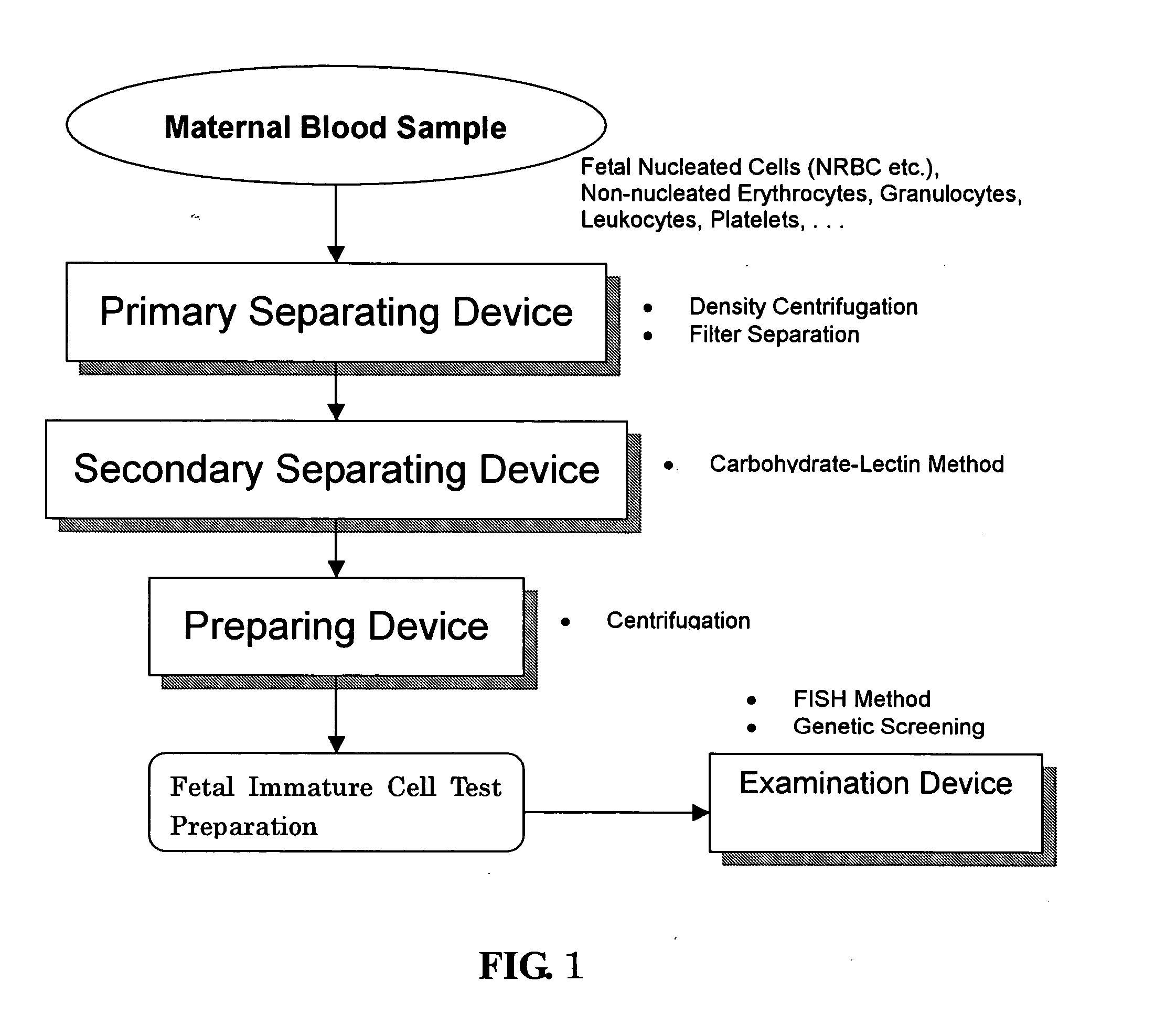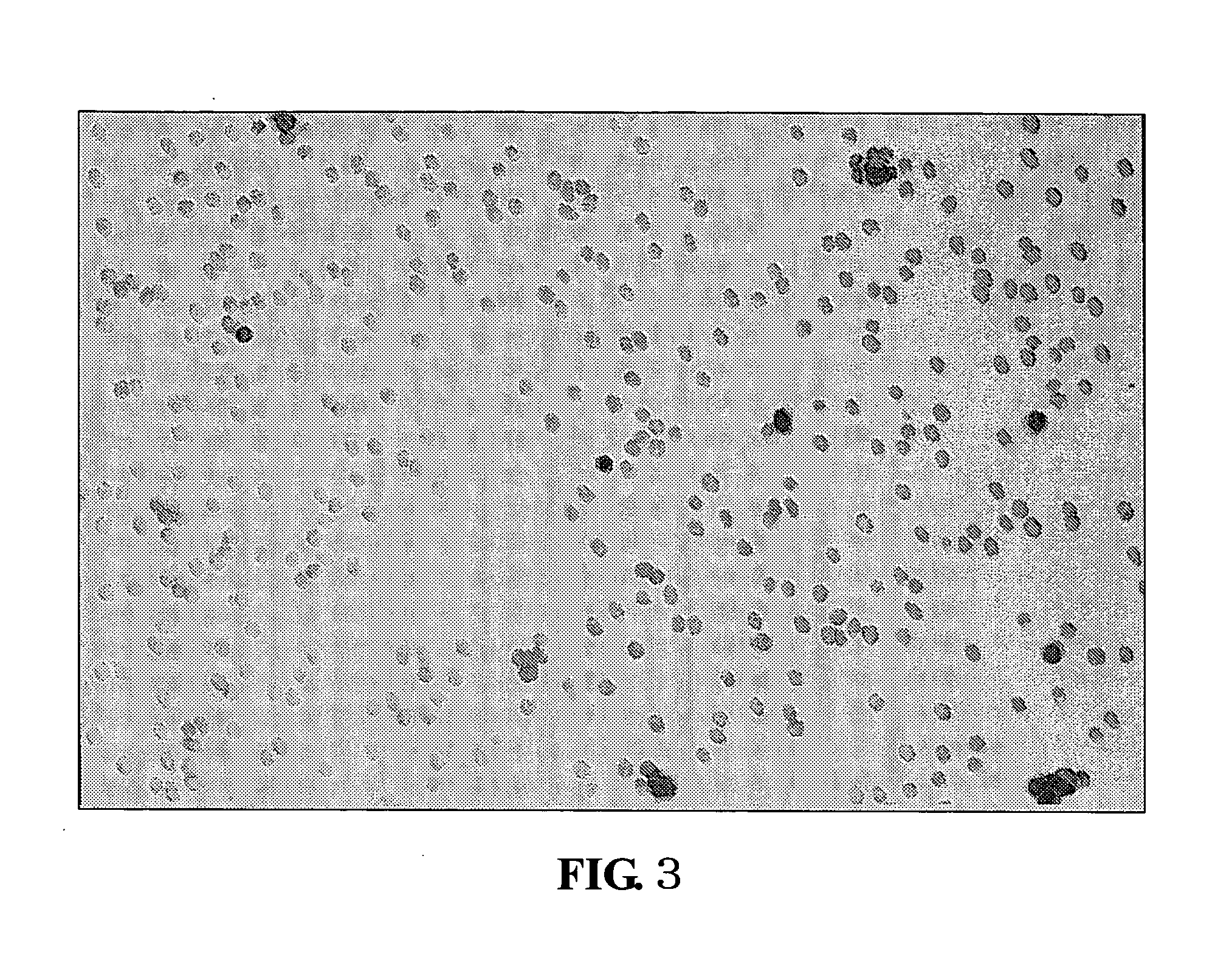Blood cell separating system
a blood cell and lectin technology, applied in the field of blood cell separation systems, can solve the problems of inability to extract lymphocytes having a y chromosome from an entire group of similar lymphocytes, high risk of miscarriage, and inability to achieve the effect of nylon wool columns or density centrifugation
- Summary
- Abstract
- Description
- Claims
- Application Information
AI Technical Summary
Benefits of technology
Problems solved by technology
Method used
Image
Examples
example 1
Primary Separation by Density Centrifugation
[0064] Histopaque (Sigma) was obtained to use as a density centrifugation reagent, to which sodium diatrizoate was added and 6 types of density gradient fluid with specific gravities adjusted to 1.077-1.105 were prepared. 7 cc of venous blood were taken from women who were 10-20 weeks pregnant, then centrifugated for 30 minutes in each density gradient fluid (20° C., 1500 rpm). The cells collected around the boundary between the density gradient fluid and plasma component (upper layer) were recovered, then centrifugally rinsed with a biological buffer solution to obtain a crude separated sample with most of the non-nucleated erythrocytes and platelets removed.
[0065] The samples primarily purified under the various density conditions were secondarily separated by the carbohydrate-lectin method. As the substrate, a plastic chamber slide (2 wells, product of Nalgenunc) was used. The glycoconjugate polymer coated onto the substrate was PVMeA...
example 2
Additional Separation by Panning
[0067] A plastic chamber slide (4 wells, product of Nalgenunc) was treated with FCS or a 0.01 wt % aqueous solution of a glycoconjugate polymer (PV-Sugar) (product of Netech). As the glycoconjugate polymer, those having the structures of glucose, maltose, gluconic acid, N-acetylglucosamin, mannose, lactose or melibiose were used.
[0068] Density gradient centrifugation was performed on umbilical blood recovered after birth according to a standard method using Histopaque (d, 1.095), and the cells aggregating near the boundary between the Histopaque and plasma were collected. The samples were resuspended in RPMI1640 to which 10 wt % FCS was added, and inoculated onto the above-described wells whose surfaces were coated with FCS or glycoconjugate polymers. After incubation for 30 minutes at 37° C., the unattached cells were recovered in the form of a cell suspension fluid, and the cells attached to the wells were stained with a Pappenheim stain to identi...
example 3
Primary Separation by Filter Separation
[0073] Instead of the density centrifugation method of Example 1, a primary separation was performed using a filter comprising an unwoven polyester fabric with an average pore size of 8 μm. A sample of maternal blood was diluted with a biological buffer solution containing 1 wt % BSA, then passed through the filter by natural dripping. Next, the buffer solution alone was passed through a filter to rinse away the residual erythrocytes in the filter. Subsequently, the buffer solution was passed in the opposite direction with a syringe pump, and the unattached cells which did not pass through the filter were recovered. The cell fraction which did not pass through the filter but did not strongly adhere to the filter was taken as the primary separated sample, which was secondarily separated by the carbohydrate-lectin method. Table 4 shows the results with a primary separated sample obtained from the above-described filter, in the form of a comparat...
PUM
| Property | Measurement | Unit |
|---|---|---|
| density | aaaaa | aaaaa |
| temperature | aaaaa | aaaaa |
| temperature | aaaaa | aaaaa |
Abstract
Description
Claims
Application Information
 Login to View More
Login to View More - R&D
- Intellectual Property
- Life Sciences
- Materials
- Tech Scout
- Unparalleled Data Quality
- Higher Quality Content
- 60% Fewer Hallucinations
Browse by: Latest US Patents, China's latest patents, Technical Efficacy Thesaurus, Application Domain, Technology Topic, Popular Technical Reports.
© 2025 PatSnap. All rights reserved.Legal|Privacy policy|Modern Slavery Act Transparency Statement|Sitemap|About US| Contact US: help@patsnap.com



